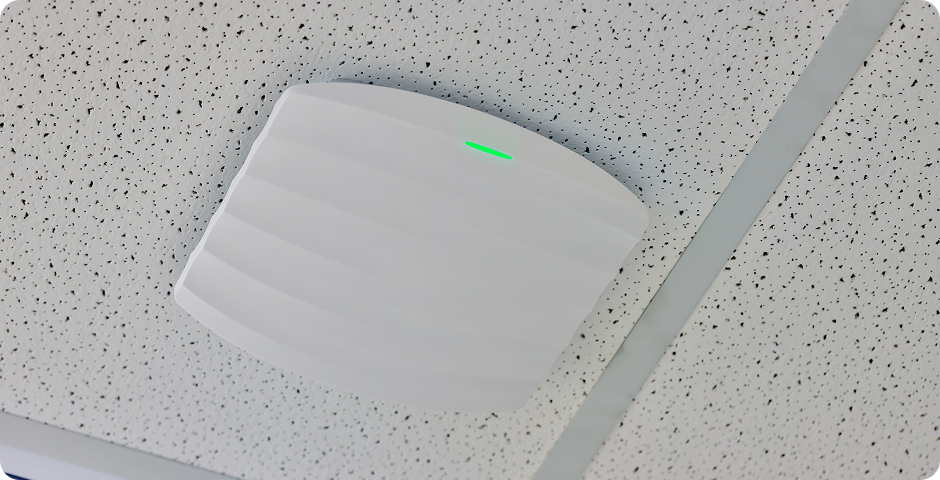Dedicated vs Shared Fiber Networks: What Business Owners Need to Know
American businesses are increasingly dependent on reliable, high-speed internet. From e-commerce to video conferencing to cloud-based software, virtually all of our work is connected to the internet somehow.
Andrew Bruley-Moore
Network Engineer
Business Internet

If you’re exploring business internet options, you’re likely aware of the massive benefits of fiber for business owners, but do you need your own fiber network or can you share with a neighbor?
In this article, we’ll explore the key differences between dedicated and shared fiber, and help you decide which option delivers the speed, security, and reliability your business needs to thrive.
What is Fiber internet?
Fiber internet is a type of service that uses fiber-optic cables made of small, flexible glass strands to transmit data via light. This technology enables better speed, reliability, and security than traditional cable internet. Light signals can travel faster and more reliably over long distances and carry more data than traditional copper internet cables.
What is a Dedicated Fiber Network?
A dedicated fiber network, also referred to as “Direct Internet Access” (DIA), provides a private, secure connection for businesses who need high bandwidth, and increased speeds and security from their network provider. If you often send or receive large files from clients, use video conferencing software, or accept online transactions, a dedicated business-grade fiber network will likely improve your business’s speed and efficiency so you can reach your growth goals faster.
What is a Shared Fiber Network?
A shared fiber network, as the name suggests, is a single strand of optical fiber used to provide internet access to multiple destinations or customers. Shared networks are also referred to as “Passive Optical Networks” (PON). Unlike a dedicated fiber network, PONs use a single fiber strand to serve up to 32 customers.
The biggest variable with a shared fiber network is speed. Shared networks offer asynchronous connections, meaning that your upload and download speeds will be different and your browsing speeds may be throttled during peak hours.
Shared fiber networks are more affordable than dedicated fiber networks, making them one of the best internet options for small businesses, startups, and residential customers who don’t need consistently high speeds to be successful.
Dedicated vs Shared Fiber: Key Differences
Both dedicated and shared fiber networks have their benefits and drawbacks, and you’re probably wondering which option is best for your business. Here are some of the key differences between private and shared fiber networks to help you decide:
- Speed and Bandwidth: In contrast to a shared network, dedicated fiber offers guaranteed synchronous bandwidth 24/7. During peak usage hours, shared subscribers will have significantly less bandwidth available since they are sharing a single cable with other users. Dedicated networks do not get clogged with other users, meaning you get access to fast, reliable internet access whenever you need it.
- Reliability: Fiber internet, whether dedicated or shared, is generally incredibly reliable. However, due to variable speeds during peak hours, shared fiber users may experience lower reliability in exchange for cheaper internet access.
- Security: Private fiber networks offer enhanced security measures, including firewalls and encryption protocols, making it a better choice for businesses who handle sensitive data like health information or credit card numbers. Shared networks increase the risk of unauthorized access or data breaches if proper
security measures aren’t in place for each user on the network. - Scalability: Dedicated fiber networks can be easily scaled up or down depending on your business’ needs or usage. This is very useful for companies who expect to grow quickly and need all employees to have access to consistent internet speeds, reliability, and security. Shared Fiber networks are limited to their scalability due to the resources of this connection being shared with other users.
- Cost Considerations: Because of the increased speeds, reliability, and security customers get with a dedicated fiber network, installation and service costs will be higher than those of a shared network. However, as technology advances quickly, fiber access is becoming more and more common, which will reduce prices in the long run.
Is Dedicated or Shared Fiber Right for Your Business?
Dedicated fiber networks have a lot of appealing benefits, including consistently high speeds, reliability, and constant availability. While shared networks are more affordable, private fiber networks are the superior choice for businesses who need to conduct video conferencing, upload files to the cloud, or use a lot of data each day.
Customers that may benefit from a dedicated fiber network include:
- Remote teams that use cloud-based software and storage
- High-security industries like finance, healthcare, and technology
- Fast-growing companies that need the ability to scale quickly
Customers who may be a good fit for a shared fiber network include:
- Small offices with basic internet needs
- Budget-conscious startups who are just starting out
- Residential users who don’t need consistent upload and download speeds
Consider FirstDigital for Your Fiber Internet Needs
In today’s digital-first world, the type of internet connection your business relies on can directly impact productivity, customer experience, and your bottom line. While shared fiber may be a suitable starting point for smaller teams or budget-conscious startups, dedicated fiber is the gold standard for businesses that require consistent speed, security, and scalability. It’s a strategic investment in your infrastructure—one that can support everything from seamless video conferencing to fast, secure data transfers as your business grows.
If your business depends on always-on connectivity and high performance, now is the time to explore how a dedicated fiber solution can support your goals. Learn more about how FirstDigital can provide the speed, security, and service your business deserves. Don’t let your internet hold you back—upgrade to a solution built for growth.
Heading 1
Heading 2
Heading 3
Heading 4
Heading 5
Heading 6
Lorem ipsum dolor sit amet, consectetur adipiscing elit, sed do eiusmod tempor incididunt ut labore et dolore magna aliqua. Ut enim ad minim veniam, quis nostrud exercitation ullamco laboris nisi ut aliquip ex ea commodo consequat. Duis aute irure dolor in reprehenderit in voluptate velit esse cillum dolore eu fugiat nulla pariatur.

Block quote
Ordered list
- Item 1
- Item 2
- Item 3
Unordered list
- Item A
- Item B
- Item C
Bold text
Emphasis
Superscript




